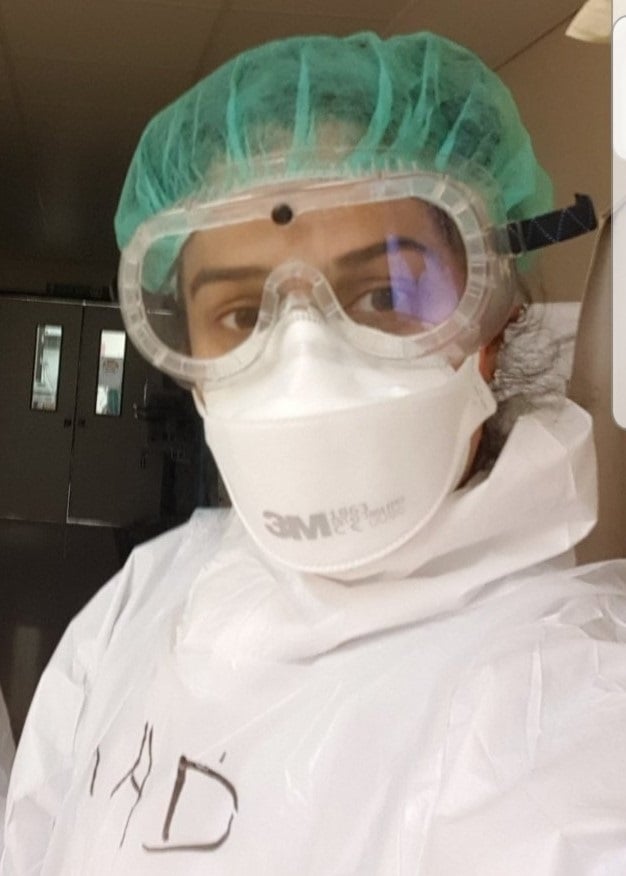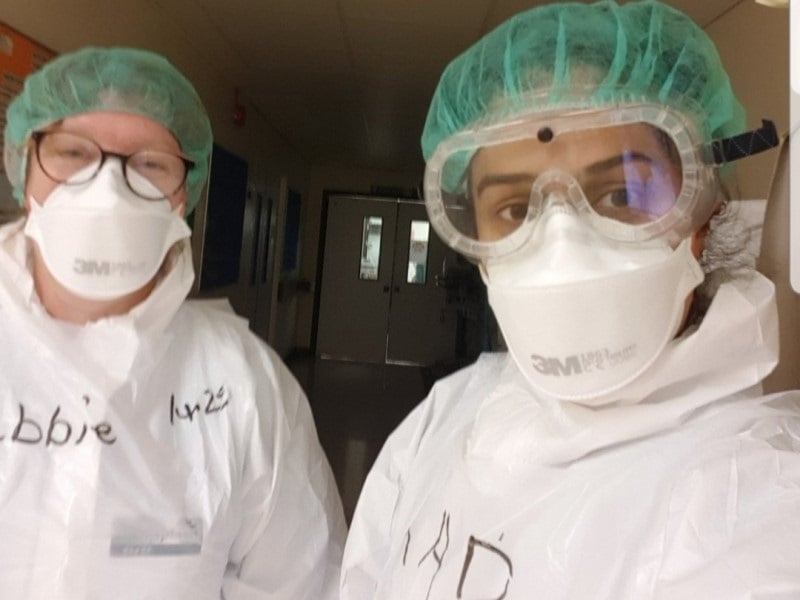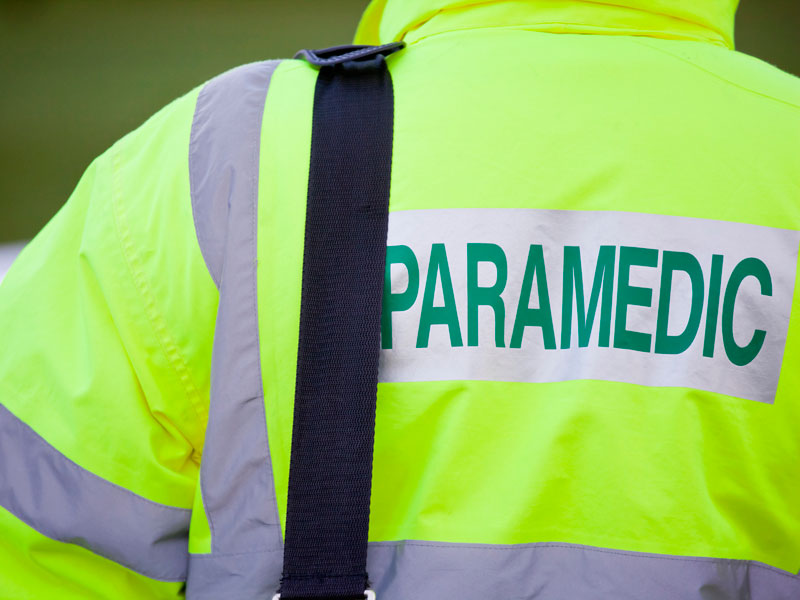Khadijah Nazir Salim is a highly specialised podiatrist (diabetes and vascular) working for Oldham Care Organisation, part of the Northern Care Alliance NHS Group.
COVID-19 has presented several changes for many of our registrants including having to adapt to different settings or adjust to new measures such as PPE. You can read more about how to apply our standards during this time, and in particular helpful information about scope of practice, managing risk: infection prevention and control and balancing service user needs during a pandemic.
Khadijah shares her story
Prior to the Pandemic, my normal job consisted of working within outpatient clinics and inpatient wards at Oldham hospital. The majority of my caseload consisted of patients with diabetes or those with vascular insufficiency who had either undergone lower limb amputations from foot infection and gangrene or patients who had infected foot wounds.
At the beginning when I watched the all the media reports about the virus, it initially felt like it was on the other side of the world. Once the first patient was admitted to the hospital with coronavirus it still didn’t hit home about how serious this was going to be.

I have thought about what one word I could use to describe the past year and the term surreal comes to mind.
At the start of last year, we were all making plans for holidays, milestone birthday celebrations and weddings. I would never have imagined we would have experienced what we have since then.
At the start of the pandemic, it was recommended by NHS England that Diabetes MDT foot clinics would still need to run as is they are classed as an essential service. Our team is only very small, so it meant ensuring the right allocation and skill mix of staff to cover these clinics and the increasing number of patients on the ward.
Ambulances services were unable to provide patient transport to the foot clinics, so this meant that those patients who were at the highest risk of amputation were unable to attend the specialist MDT service. We also found that those patients with underlying health conditions who had received shielding letters did not want to leave their homes.
In addition to this, many of our community podiatrists were redeployed into other services such as district nursing teams. We acknowledged the input these high-risk patients needed and felt responsible that we could not let patients at home fall through the net.
As a result, the team set up an MDT outreach service and we identified those patients who had received shielding letters and did not want to attend and those patients who were unable to attend due to transport issues. We then visited these patients at home. We ensured the podiatrists who assessed these patients were independent prescribers and had access to FP10 pads and IV services.
Once at the patient’s home we were able to use Microsoft teams to videocall, send images and seek advice from the diabetes and vascular team. This enabled patients to have remote MDT reviews and also reduced the workload of the community staff.
For many of us we had not been out on domiciliary visits for nearly 10 years. We had to make sure we were very organised in what equipment and PPE we took out for the visits. It’s not like we could walk into the clinical cupboard and get what we needed.
On the wards we were seeing an increase in the number of patients who were being admitted in an acutely unwell stage. These patients had tested positive for COVID-19 and also sepsis from infected foot wounds. These patients were receiving the highest level of care in our ICU department.
The first time I went to ICU was a daunting experience. We decided it would be better to treat these patients on ICU in twos. When we arrived on ICU all the PPE was laid out. It felt very overwhelming and I had found I had got myself worked up about applying the correct level of PPE and in the right order. ICU had a staff member who was present at the PPE station. This staff member helped you apply your PPE in the exact order it needed to be worn. The staff member must have gone through the process with staff several times that day but each time they took the time and patience to explain how and why to apply the PPE in that order.
As soon as we had ‘donned-on’ the PPE, the feeling of claustrophobia and panic kicked in. I couldn’t imagine how ICU staff were able to work full shifts in this. The patients on ICU would take longer than patients on medical wards. Due to the eye protection and tight fitting FFP3 masks it often made debridement of wounds a difficult and prolonged process. We found over the weeks the treatment patients required on ICU became more complex.
We went from simple debridement of wounds to sharp debridement of necrotic tissue to prevent surgery; to making heel casts to offload vulnerable heels. We even managed to apply several bags of larvae to an amputation site of a patient ventilated on ICU. Our most challenging treatment was the application of negative pressure wound therapy on bilateral surgical heel wounds. It was during the summer on the hottest day of the year and as the sweat dripped down, all I could think was please let us achieve a seal first time!
ICU was a heart-breaking environment. It was full of patients who were receiving the highest level of care, ventilated and very unwell. These patients were surrounded by pictures and letters of family, reminding you of loved ones waiting for them to return home.
ICU was full of patients from young to old and every time we went on the ward the patients had changed. Some were well enough to be stepped down but the majority we realised had not made it. Donning off once off ICU often left us feeling relieved to have taken the PPE off but also emotionally drained at what we had witnessed.
My personal battle with COVID-19
Outside of work I really struggled with the implications of treating COVID-19 patients. My parents are classed as high risk and had been shielding. I am particularly close to my parents and siblings and it was upsetting and difficult not being able to see them to celebrate birthdays, Eid and just to have a chat. We all tried to keep in contact using facetime to ensure the grandchildren still had some sense of normality.
A few months ago, I tested positive for COVID-19 myself. It started with a headache which I normally don’t suffer from and then lost my sense of taste and had a fever and chills. My husband then became symptomatic and tested positive a few days later. It was difficult both of us being unwell and having two young children to look after. I couldn’t rely on family members to help us out like they normally would.
My work colleagues kept in contact with me throughout my illness, so it also helped to talk about normal things not related to COVID-19.

What keeps me going
Prior to the pandemic I had been offered a place and was training for the London Marathon.
During the height of the pandemic I struggled to switch off from work. It was very easy to work past my normal working hours just to get the work done. I found I was working 40+ hours a week on a regular basis. We even worked during bank holiday weekends to ensure the patients were seen.
I’m very lucky that my colleagues in my immediate team and wider team were all very supportive of one another. It was easier to speak about what we were all going through. We all focused on helping each other get the job done.
We have a particularly good working relationship with our specialist vascular nurses. We were able to share our patient workload. It also meant we were all able to apply our specialist knowledge and skills to jointly review these high-risk patients.
It has also been nice to see some of the patients we treated on ICU have gone home and are now well enough to attend our outpatient clinics.
I’m sure over the past months we have all felt anxious, scared, guilty and frustrated. I know at some points I have also had sudden surges of adrenaline to just get through the day.
It is very easy to say to each other try and strike a healthy work life balance. It is very hard to achieve. I think the first step is to acknowledge what we are all going through and what we have felt.
I have found writing things down helps me organise what I need to do each day. I find I don’t get anxious now about missing something important or forgetting to do something. With the closure of the gyms I found I wasn’t making the effort to exercise. Now I try to ensure I go running on a regular basis. I actually add it to my list of things I need to do!
Although the pandemic was and continues to be challenging, I am proud to have worked on the frontline, supporting my profession and colleagues, and that I have contributed in some way to saving patients limbs and lives.
- Published:
- 24/03/2021
- Resources
- In your words
- Subcategory:
- COVID-19
- Profession
- Chiropodists / podiatrists

